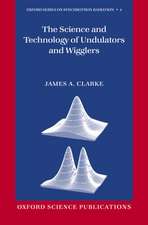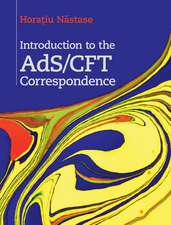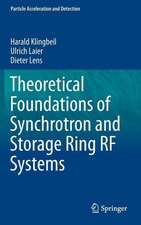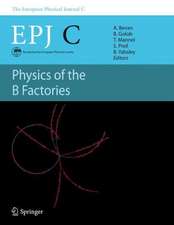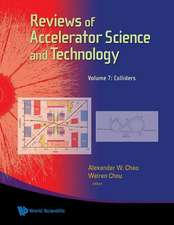Particle Detectors: Fundamentals and Applications
Autor Hermann Kolanoski, Norbert Wermesen Limba Engleză Hardback – 30 iun 2020
Preț: 694.74 lei
Preț vechi: 787.45 lei
-12% Nou
Puncte Express: 1042
Preț estimativ în valută:
132.94€ • 142.16$ • 110.84£
132.94€ • 142.16$ • 110.84£
Carte tipărită la comandă
Livrare economică 07-14 aprilie
Preluare comenzi: 021 569.72.76
Specificații
ISBN-13: 9780198858362
ISBN-10: 0198858361
Pagini: 950
Ilustrații: 383 grayscale and 141 color line figures, and 20 grayscale and 33 color halftones
Dimensiuni: 178 x 248 x 50 mm
Greutate: 1.81 kg
Ediția:1
Editura: OUP OXFORD
Colecția OUP Oxford
Locul publicării:Oxford, United Kingdom
ISBN-10: 0198858361
Pagini: 950
Ilustrații: 383 grayscale and 141 color line figures, and 20 grayscale and 33 color halftones
Dimensiuni: 178 x 248 x 50 mm
Greutate: 1.81 kg
Ediția:1
Editura: OUP OXFORD
Colecția OUP Oxford
Locul publicării:Oxford, United Kingdom
Recenzii
Starting from a thorough introduction of fundamentals easily understood by the non-specialist and arriving at the cutting edge of modern device application, this well-produced volume offers an important reference for researchers and students in physics and optics.
a gem of a book... easy to read and conceptual discussions are well supported by numerous examples, plots, and illustrations of excellent quality.
...the authors provide the community with a fantastic resource for all aspects of modern instrumentation in the scientific and societal applications of particle physics. This monumental textbook, with its almost 1000 pages, covers in a very comprehensive, clear and inclusive way all the basic physics and technologies for detectors. Each of the topics is introduced in an accessible manner for advanced graduate students, including concrete examples, and is then further developed in depth for experts. This also makes it a precious reference book.
Before I opened the cover of the book, I made a list of topics that I feel should be covered in a comprehensive treatise on particle detection. As I read through, I found that each one of those, and many more, are treated with an admirable balance of technical depth and readability. I highly recommend this book for any "student" of nuclear instrumentation, whether at the beginning of or deep into their career. The book promises to be an invaluable resource for many years to come.
a gem of a book... easy to read and conceptual discussions are well supported by numerous examples, plots, and illustrations of excellent quality.
...the authors provide the community with a fantastic resource for all aspects of modern instrumentation in the scientific and societal applications of particle physics. This monumental textbook, with its almost 1000 pages, covers in a very comprehensive, clear and inclusive way all the basic physics and technologies for detectors. Each of the topics is introduced in an accessible manner for advanced graduate students, including concrete examples, and is then further developed in depth for experts. This also makes it a precious reference book.
Before I opened the cover of the book, I made a list of topics that I feel should be covered in a comprehensive treatise on particle detection. As I read through, I found that each one of those, and many more, are treated with an admirable balance of technical depth and readability. I highly recommend this book for any "student" of nuclear instrumentation, whether at the beginning of or deep into their career. The book promises to be an invaluable resource for many years to come.
Notă biografică
Hermann Kolanoski is Emeritus Professor of Physics at the Humboldt University Berlin and at the research centre DESY (Zeuthen). After having received his doctoral degree in Bonn he worked at universities in Stanford, Bonn and Dortmund before joining Humboldt University in 1995. His field of expertise is experimental particle and astroparticle physics. He currently participates in research with the IceCube Observatory at the South Pole and ATLAS at CERN. His work in detector development includes gaseous wire chambers, calorimeters, photon detectors, and trigger electronics as well as applications in medical physics.Norbert Wermes is Professor of Physics at the University of Bonn. His field of research is experimental particle physics and detector physics. He has conducted research with experiments at the particle physics research centres DESY (Hamburg), SLAC (Stanford), Fermilab (Chicago), KEK (Tsukuba), and CERN (Geneva). After graduating with a PhD in physics from the University of Bonn, he was a postdoc at Stanford University, and a CERN staff scientist. In 1989 he became a professor at the University of Heidelberg, before returning to Bonn in 1992. With his group, he currently carries out research with the experiments ATLAS (CERN) and Belle II (KEK). In detector physics, his focus is on semiconductor pixel detectors and microelectronics.




